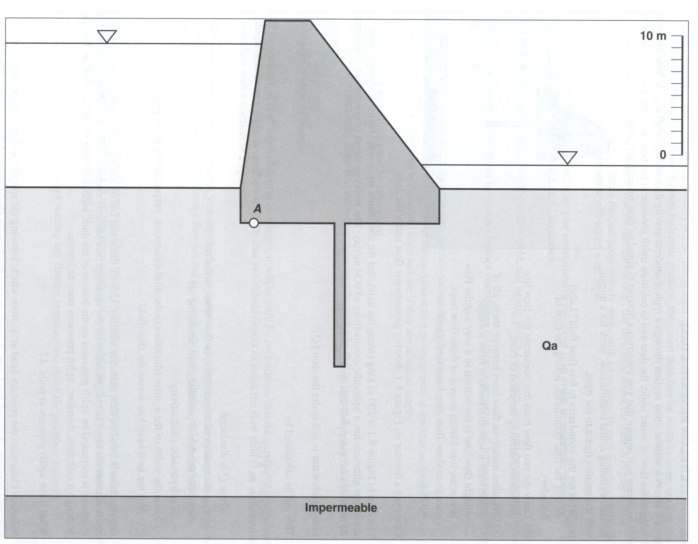1. Construct a flow net on Figure 1 showing groundwater flow under the dam. 2. The dam in Figure 1 is 100 m long (along the axis), and the abutments are in solid bedrock. Aquifer tests have shown the alluvium has a hydraulic conductivity of 4 x 10-5 m/s. The reservoir depth is maintained constantly at 12 m, with a tailwater pool 2 m deep. How much water is lost under the dam (Q)? 3. Gravity dams depend on their mass for stability. Gravity dams can fail by sliding or by tipping over, that is, by rotation about the toe if lateral pressures on the upstream face become excessive. The probability of either type of failure is increased by uplift pressures on the bottom of the dam, especially near the upstream face. In order to design a safe dam, therefore, uplift pressures must be known. What is the uplift pressure at point A?
Figure shows a vertical cross section through a typical concrete gravity dam with a cutoff trench.
You are asked to determine the flow of water under the dam and to calculate uplift pressure at the
bottom of the dam. The solution to both problems will require that you construct a flow net to
simulate flow beneath this dam.
1. Construct a flow net on Figure 1 showing groundwater flow under the dam.
2. The dam in Figure 1 is 100 m long (along the axis), and the abutments are in solid bedrock.
Aquifer tests have shown the alluvium has a hydraulic conductivity of 4 x 10-5 m/s. The reservoir
depth is maintained constantly at 12 m, with a tailwater pool 2 m deep.
How much water is lost under the dam (Q)?
3. Gravity dams depend on their mass for stability. Gravity dams can fail by sliding or by tipping
over, that is, by rotation about the toe if lateral pressures on the upstream face become excessive. The
probability of either type of failure is increased by uplift pressures on the bottom of the dam,
especially near the upstream face. In order to design a safe dam, therefore, uplift pressures must be
known.
What is the uplift pressure at point A?
4. Determine pressure distribution at the bottom the dam?

Step by step
Solved in 4 steps with 1 images









